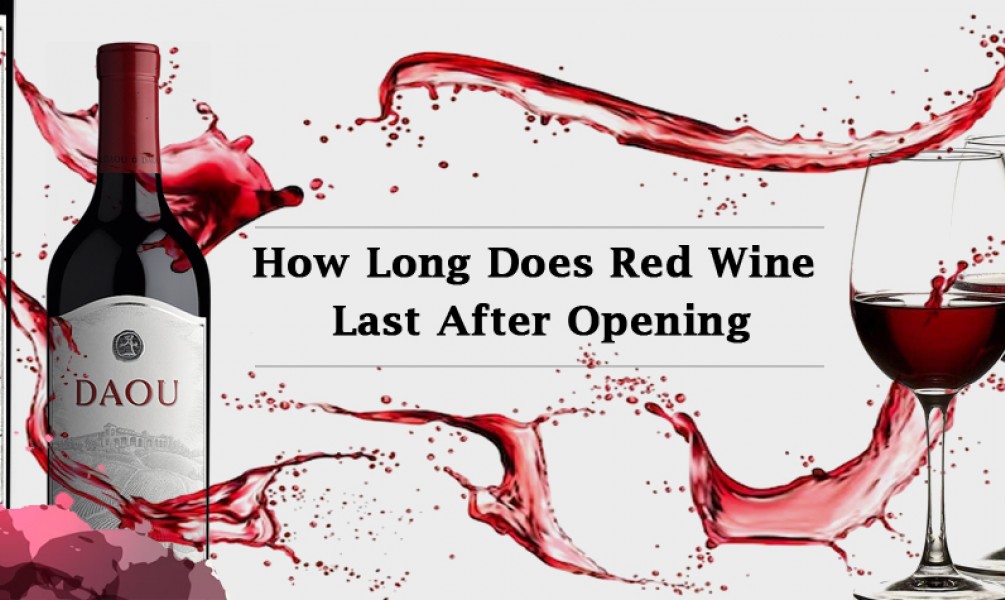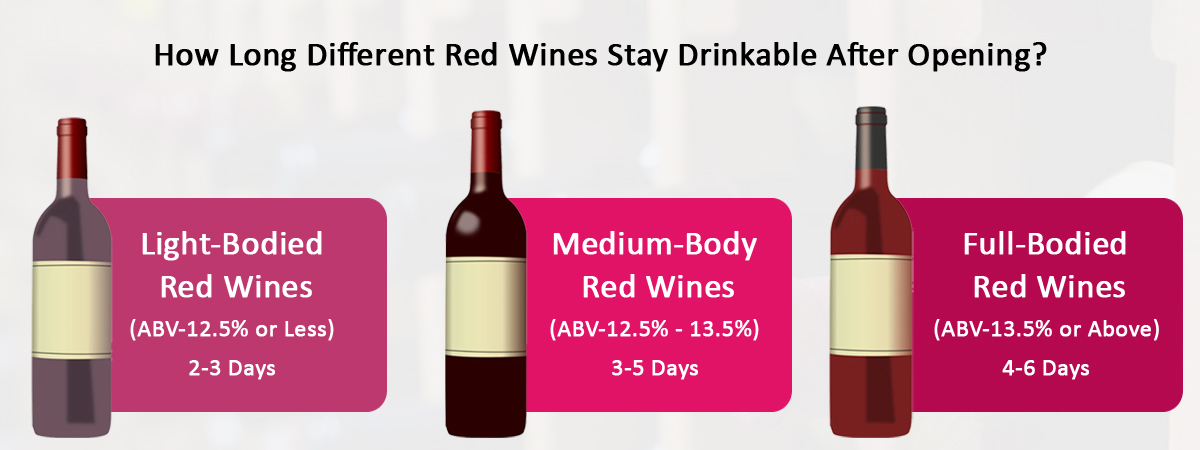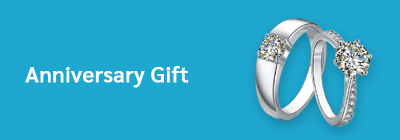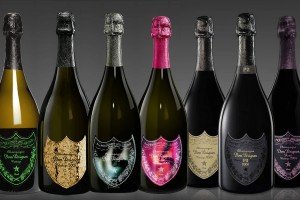
Whether you are a wine expert, a casual drinker, or a novice, it is likely that you will occasionally be left with an unfinished bottle of red wine. And preserving the taste and value of leftover red wines can be a real challenge in such cases.
- On Average, How Long Does Red Wine Last Once Opened?
- How Long Can A Bottle Of Red Wine Be Kept Unopened?
- How Long Different Red Wines Stay Drinkable After Opening?
- How Is The Drinkability Window Of A Red Wine Defined?
- What Happens To Red Wine After It Is Opened/Uncorked?
- How Will You Know If A Red Wine Has Gone Bad After It’s Been Opened?
- How To Store Unopened Red Wine Bottle?
- What Is The Best Way To Store Red Wine After Opening?
- Planning to savor the world's top red wines ?
In this article, we'll answer all of your questions about opened red wine bottles and how to deal with them like an expert - whether it's a powerful Cabernet down the shoulders of the wine bottle or a leftover Merlot from the wine case you bought for a gathering.
Come Join Us In This Vino Discovery!
On Average, How Long Does Red Wine Last Once Opened?
If stored properly, an opened bottle of red wine will normally last for 3-5 days. Also, because the life of an opened bottle of red wine is greatly influenced by its style and quality, this time period is dynamic.
A high-quality red wine, like one from Caymus or Daou, can keep for up to a week after opening; however, a low-quality wine will lose its freshness and fruit sooner. Similarly, you can expect a powerful Syrah red wine to last longer than a light-bodied Grenache red wine. (We'll go over how long each type of red wine lasts later.)
How Long Can A Bottle Of Red Wine Be Kept Unopened?
We only had a brief tour of how long does an open bottle of red wine lasts. But what about a brand-new bottle of red wine? How long does it remain safe to drink? When to drink a red wine that is unopened?
Whatever red wine you choose, it begins the process of micro oxygenation the day it is bottled since there are traces of oxygen in the bottle that permeate the closure and work on the organic molecules of the wine.
The wine starts breaking down as it ripens and keeps getting better until it achieves its "Height of Ideal Drinkability". This best state is referred to as the "Drinkability Window" of a wine. When red wine reaches this point, its quality starts to decline at a significantly faster rate.
How Long Different Red Wines Stay Drinkable After Opening?
The world of red wines is now as diverse as the world of wines. There are over 50 different types of red wines in the globe, and individually calculating how long does red wine last can be difficult.
So we've classified red wine varieties to help answer the question of how long can red wine be open.

Light-Bodied Red Wines:
The family of light-bodied red wines includes your favorite Grenache and Pinot Noir. These reds feature a red flora profile as well as a low alcohol (12.5% or less), tannin, and acidity range. They are drinkable for 2-3 days and do not last as long as a medium or full-bodied red wine.Medium-Body Red Wines:
These wines have moderate alcohol (12.5% - 13.5%), varietal fragrance characteristics, and balanced tannin with moderate acidity. Merlot and Shiraz are two examples. They are usually drinkable for 3-5 days after the wine bottle has been opened.Full-Bodied Red Wines:
Full-bodied red wines have a thick and viscous mouthfeel. They are heavy in the mouth, usually leave a dry aftertaste, and contain elevated amounts of alcohol (13.5% or above) and tannins. Zinfandel and Cabernet Sauvignon are popular varieties that keep for 4-6 days.
How Is The Drinkability Window Of A Red Wine Defined?
Each red wine has its own qualities that make it build its own "Drinkability Window". Acidity, sugar, and tannins are the most key contributing factors. The acidity of the red wine maintains it fresh and lively, while tannins combat oxygenation and the ageability of wine in general.
As a result, it is acceptable to state that a red wine with greater features lasts longer, achieves its drinkability peak later, and may thus be left unopened for a longer amount of time. Your Tuscan wine or Merlot can mature in a bottle for 10-20 years, whilst bolder red wines like Cabernet Sauvignon and Brunello di Montalcino can age for more than 20 years.
What Happens To Red Wine After It Is Opened/Uncorked?
When you open a bottle of red wine, it is exposed to a new environment that is not the bottle itself. The red wine will coalesce with the oxygen in the air and will be influenced by factors such as humidity, temperature, and light.
The oxidation process will gradually diminish the red wine, causing its fresh fruit flavors to fade and aromatics to flatten out. Older wines and those with lighter bodies will fade faster than young and full-bodied wines.
The alcohol content will not alter when exposed to air, but it will progressively evaporate if stored improperly. Because red wine contains water, it will begin to evaporate as well, although at a slower rate.
How Will You Know If A Red Wine Has Gone Bad After It’s Been Opened?
We just talked about how long can you keep opened red wine depending on its amount of alcohol, acidity, tannin level, and palate. And it is a dynamic issue because red wine might go bad sooner or later depending on other criteria such as age, quality, and storage conditions.
So, How Will You Know If An Opened Bottle Of Red Wine Has Gone Bad?
The technique for detecting bad red wine is the same as for detecting fresh wine. A terrible red wine is defined by its unpleasant appeal to your senses of sight, smell, and taste. So check these parameters to know how to spot a red wine that has gone bad after it’s been opened:
Appearance:
At first glance, a bad red wine will appear fully or partially different from a fresh wine. It will not be lustrous and will have a faded tint. When exposed to air, microbial activity stresses the red wine, turning it dark, hazy, or frothy.Smell:
A lousy red wine can truly irritate your olfactory system. When red wine is exposed to air for an extended period of time, it undergoes a variety of chemical reactions that cause it to smell sharp and abrasive. It smells very similar to nail polish remover or vinegar that feels scratchy in your nasal canal.Flavor:
Finally, a red wine fails due to its terrible taste. When a red wine becomes bad, the flavor profile completely loses its energy. On the palate, it will most likely taste like vinegar, both sour and bitter.
How To Store Unopened Red Wine Bottle?
Wine can be quite sensitive to a wide variety of environmental variables. To ensure that your wine lives up to its full potential, keep the following factors in mind:
Light:
Sunlight or artificial light that is excessively bright might degrade the wine's aromas and flavors. So keep wine in a cool, dark place.Temperature:
Because cold temperatures (preferably 55° F) slow the aging process, storing your new red wine in a cool place is essential. However, take care not to freeze the wine. Use a wine chiller, rack, or fridge.Vibration:
Vibrations can disturb the sediments in the wine, causing it to lose aroma or become too sweet. So keep wine in a vibration-free environment.
What If You Drink A Bad Red Wine That Has Been Open For A Long Time?
Did you just drink a bottle of red wine you left on the shelf a week ago? Relax, you don't need to go to the doctor. A bad red wine can be unpleasant but not harmful. When you sip oxidized red wine, its strong taste will envelope your mouth, making it feel just terrible.
What Is The Best Way To Store Red Wine After Opening?
We've already explored how each sort of red wine has its own expiration date. But if you don't store an opened bottle of red wine right, it may not last as long. So, here is how to store the red wine when opened:
Store In A Dark Place:
By dark, we mean away from direct sunlight or utterly bright artificial light. UV radiation or brightness can harm the flavors and aromas of leftover red wine.Store In A Cool Place:
A cool environment is ideal for a red wine that has been opened. It will slow down the oxidation process and extend the life of the wine even further. 55° F is the best temperature for storing opened red wine. Try refrigerating in a wine refrigerator or chiller for the best results, although your standard fridge will work.Restrict Air Passage:
Because air is the enemy of an opened red wine, the first step in storing it is to screen it to prevent air from entering the bottle. You can opt to recap it, recork it, or use a wine stopper.
Impressive Tips for You!
- If you don't have any wine stoppers on hand or are having trouble recorking the bottle, take some plastic wrap and secure it with a rubber band to make a makeshift stopper.
- You can protect the remaining wine from oxidation by using a bottle that is smaller. This will ensure that there is no room for any air to enter the bottle.
Planning to savor the world's top red wines ?
Are you looking forward to splurging on ruby-colored red wines for forthcoming events? Then we have outstanding red wines piled for you that will be delivered across the United States in only a few clicks.
Click To Discover Top California Red Wines
There is a red wine to suit every appetite, from sweet Zinfandel to strong Tuscan to tannin-rich Cabernet Sauvignon, sourced from the world's most recognized wine regions. Whether it's a wedding, birthday celebration, a business gathering, or a warm and fuzzy family get-together, a wine bottle is the epitome of savoir faire at every occasion.








1 Comment(s)
I just finished reading your small useful page of information on Red wines. Thank you
Very informative.
When I lived in Michigan I used to make about 50 gals of blended wine.
Neighbors would line up at my door every spring. “ Is the wine ready yet”
Being my last name is Peters
My label read, Peters’ Cellars
A tiny panther in the corner of my label.
Thanks again
Leave a Comment